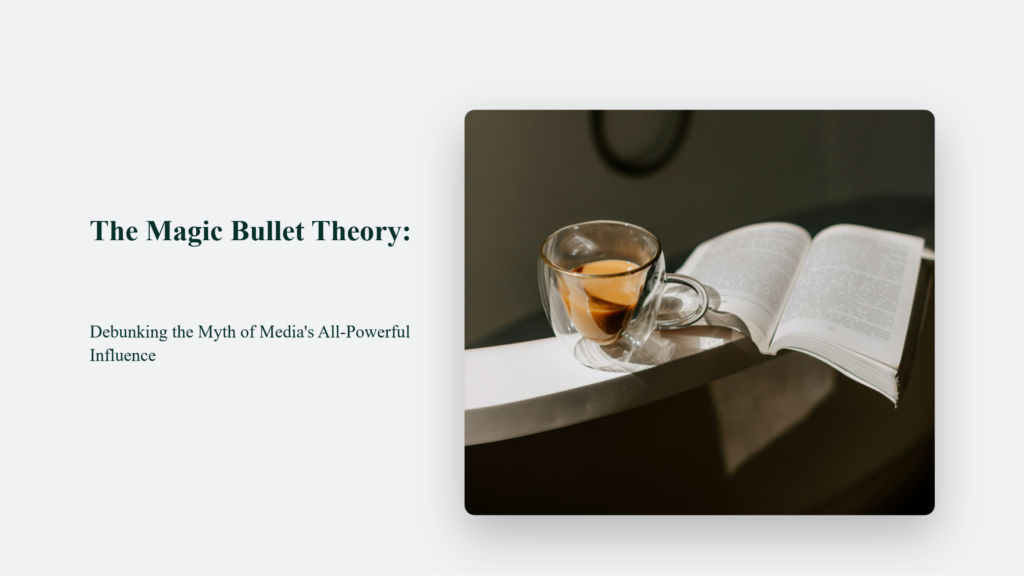![The ‘Giveaway Piggy Back Scam’ In Full Swing [2022]](https://www.cjco.com.au/wp-content/uploads/pexels-nataliya-vaitkevich-7172791-1-scaled-2-683x1024.jpg)

The Magic Bullet Theory: Debunking the Myth of Media’s All-Powerful Influence

As Seen On
The magic bullet theory is a catchy name for a once-popular idea about how media messages impact audiences. Let’s examine what is the magic bullet theory and why media scholars today largely reject it.

Key Takeaways
- The Essence of Uniform Influence: The Magic Bullet Theory posits that media messages have a uniform and immediate effect on the audience.
- Historical Context: Born out of the early 20th century, the theory reflects concerns about the power of propaganda and mass media.
- Debate on Audience Agency: The theory has sparked ongoing debate about the role of the audience in interpreting media messages.
- Relevance in the Digital Age: The theory remains relevant in understanding the influence of modern media, including social media and the internet.
What is the Magic Bullet Theory
At its core, the Magic Bullet Theory suggests that all people receive and accept media messages uniformly. Imagine a world where every word broadcasted on the radio, every headline printed in the newspaper, and every image displayed on television had the power to influence the masses instantaneously and identically. It is the world envisioned by the proponents of the Magic Bullet Theory.
A Historical Perspective:
The Magic Bullet Theory, also known as the Hypodermic Needle Model, is a model of communications suggesting a direct and powerful influence of media on a passive audience. This theory emerged in the early 20th century, a period marked by the rapid expansion of mass media and the utilization of propaganda during World War I. The world witnessed the burgeoning power of media technologies such as radio, film, and newspapers, which could reach vast audiences simultaneously.
The theory metaphorically compares media messages to bullets fired from a “media gun” into the heads of a “sitting duck” audience, implying that people are immediately and uniformly affected by these messages.
The term “hypodermic needle” is used to give a mental image of the direct, strategic, and planned infusion of a message into an individual, much like a drug is injected into a person’s bloodstream.
The historical context of the Magic Bullet Theory is deeply intertwined with the political and social upheavals of the time. During World War I, governments began to systematically use media for propaganda to maintain morale and manipulate public opinion. The effectiveness of such media campaigns in influencing the masses was impressive and alarming, leading to the belief that the media could indeed “inject” ideas into a largely defenceless audience.
This model was rooted in behaviourism, represented by experiments like Pavlov’s conditioning, where a dog was trained to salivate at the sound of a bell. The hypodermic needle model applied this concept of conditioning to the mass audience, who were seen as passive recipients of whatever message was injected by the media.
The Magic Bullet Theory was not based on empirical research but on assumptions about human nature and the power of media. It was later challenged and largely disproved by more nuanced research, particularly by Paul Lazarsfeld and his colleagues, who found that media effects were more selective and that personal attributes and social contexts influenced audience reactions.
The most famous incident often cited as an example of the hypodermic needle model was the 1938 broadcast of “The War of the Worlds” by Orson Welles, which was mistakenly believed to have caused widespread panic. However, subsequent research, including studies by Hadley Cantril and Lazarsfeld, showed that reactions to the broadcast were diverse and influenced by situational and attitudinal attributes of the listeners.
The Impact of the Magic Bullet Theory on Modern Media
The Magic Bullet Theory, also known as the Hypodermic Needle Theory, posits that media messages directly, immediately, and uniformly impact a passive audience. Although originating in the early 20th century, its principles are observed in modern phenomena such as viral marketing and political propaganda, where the media can rapidly influence public opinion.
However, the theory’s relevance is contested in the digital age, where audience diversity and access to multiple information sources challenge the notion of a passive, uniformly affected audience. Technological advancements have fostered a more critical and selective engagement with media, suggesting that while the theory’s metaphor of direct influence persists, the reality of media consumption is more complex and interactive.
The Magic Bullet Theory: A Critical Analysis
While the Magic Bullet Theory provides a foundational understanding of media influence, it is not without its critics. Many argue that the theory oversimplifies the complex media consumption process and ignores the diversity of audience interpretations. Moreover, empirical evidence suggests that factors such as personal beliefs, social context, and selective exposure play significant roles in mediating the effects of media messages.
The Bottom Line:
In conclusion, the Magic Bullet Theory offers a fascinating glimpse into the perceived power of media to shape public opinion and behaviour. While it may not capture the full complexity of media consumption, it serves as a critical starting point for understanding the potential impact of media messages on society. As we grapple with the challenges and opportunities presented by mass media, the insights provided by the Magic Bullet Theory remain as relevant as ever.
Frequently Asked Questions:
Is the Magic Bullet Theory still relevant today?
While its direct application might seem outdated, the Magic Bullet Theory serves as a crucial starting point in understanding media influence and the importance of media literacy.
Can media still have a “magic bullet” effect?
Certain messages, especially those evoking strong emotions or aligned with pre-existing beliefs, can have significant immediate impacts. However, these effects are more nuanced and variable than the theory suggests.
How can we counteract the negative aspects of media influence?
Encouraging critical thinking, fostering media literacy, and promoting diverse media consumption can empower individuals to navigate media messages more thoughtfully and critically.
Konger
Up until working with Casey, we had only had poor to mediocre experiences outsourcing work to agencies. Casey & the team at CJ&CO are the exception to the rule.
Communication was beyond great, his understanding of our vision was phenomenal, and instead of needing babysitting like the other agencies we worked with, he was not only completely dependable but also gave us sound suggestions on how to get better results, at the risk of us not needing him for the initial job we requested (absolute gem).
This has truly been the first time we worked with someone outside of our business that quickly grasped our vision, and that I could completely forget about and would still deliver above expectations.
I honestly can't wait to work in many more projects together!
Disclaimer
*The information this blog provides is for general informational purposes only and is not intended as financial or professional advice. The information may not reflect current developments and may be changed or updated without notice. Any opinions expressed on this blog are the author’s own and do not necessarily reflect the views of the author’s employer or any other organization. You should not act or rely on any information contained in this blog without first seeking the advice of a professional. No representation or warranty, express or implied, is made as to the accuracy or completeness of the information contained in this blog. The author and affiliated parties assume no liability for any errors or omissions.

